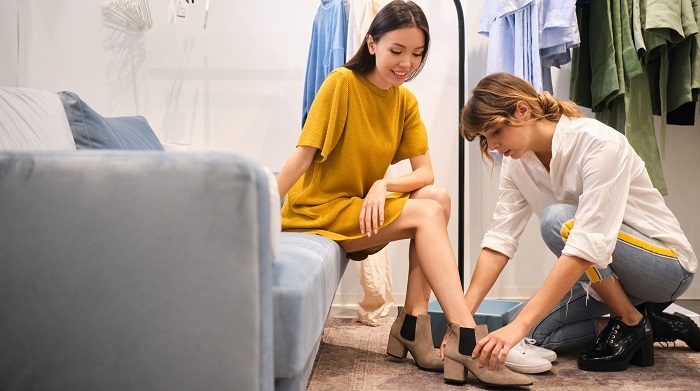

The debate between fashion and comfort has been ongoing for years. While some argue that fashion is the top priority in creating a desirable wardrobe, others prioritize comfort above all else. This topic raises important questions about individuality, societal norms, and personal values.

Fashion refers to the style, trends, and aesthetics of clothing and accessories. It can be influenced by various factors, including societal norms, cultural traditions, and personal preferences. Fashion is often associated with creativity, self-expression, and individuality.
Comfort, on the other hand, refers to the physical ease and wellbeing provided by clothing. Comfortable clothing is typically loose-fitting, made from soft and breathable materials, and designed for ease of movement. Comfort is often associated with practicality, functionality, and health.
In the debate between fashion and comfort, it is important to balance both factors when making clothing choices. Clothing that is both fashionable and comfortable can help individuals express their personal style while also promoting physical comfort and wellbeing.
Here are some common arguments against prioritizing fashion over comfort −
Physical discomfort − Clothing that prioritizes fashion over comfort can be physically uncomfortable. For example, high heels can cause pain and damage to the feet, and tight clothing can restrict movement and cause discomfort.
Health risks − Clothing that is too tight or constricting can also have health risks, such as restricting blood flow or causing nerve damage.
Unrealistic beauty standards − Prioritizing fashion over comfort can contribute to unrealistic beauty standards and the pressure to conform to a certain body type or style.
Environmental impact − The fashion industry has a significant impact on the environment, and prioritizing fashion over comfort can contribute to the production of clothing that is unsustainable and harmful to the planet.
Expensive − High-fashion clothing can be very expensive, and prioritizing fashion over comfort can lead to overspending and financial strain.
Overall, these arguments suggest that prioritizing fashion over comfort can have negative physical, societal, and environmental consequences. It is important to consider the practicality and functionality of clothing, as well as the impact on personal values and societal norms.
Here are some common arguments in favour of prioritizing fashion over comfort −
Self-expression − Fashion allows individuals to express their creativity and personal style through clothing choices. This can contribute to a sense of identity and confidence
Professionalism − In some settings, such as the workplace or formal events, fashion is an important aspect of presenting oneself as professional and put-together.
Societal norms − Fashion can be influenced by societal norms and expectations, and prioritizing fashion over comfort can help individuals fit in and feel more confident in social situations.
Boosting mood and self-esteem − Wearing clothing that is fashionable and stylish can boost mood and self-esteem, leading to positive effects on mental health.
Innovation − The fashion industry is constantly evolving and pushing boundaries, leading to new trends, styles, and innovations in clothing design.
Overall, these arguments suggest that prioritizing fashion over comfort can have positive effects on self-expression, professionalism, societal norms, and mental health. It is important to balance these factors with considerations of practicality and functionality in clothing choices.
Practicality and functionality are important factors to consider when choosing clothing, and they can play a significant role in the overall balance between fashion and comfort. Here are some ways in which practicality and functionality can impact clothing choices −
Climate − Depending on the climate and weather conditions, practicality and functionality may need to take priority over fashion and comfort. For example, during extreme cold or heat, clothing that provides warmth or breathability may be necessary for physical comfort and safety.
Activitie − The practicality and functionality of clothing may also be influenced by the activities an individual engages in. For example, work attire may need to prioritize practicality and functionality for specific tasks, such as protective gear for construction work or professional attire for business meetings.
Mobility and Accessibility − Clothing choices may also need to prioritize practicality and functionality for individuals with disabilities or mobility issues. Clothing that is easy to put on and take off or that provides accessibility features, such as magnetic closures or adaptive clothing, may be necessary for physical comfort and ease of movement.
Incorporating practicality and functionality into clothing choices can enhance the balance between fashion and comfort. Clothing that is both fashionable and functional can promote physical comfort, safety, and overall wellbeing while also allowing for individual self-expression and personal style.

Fashion and comfort can have significant psychological effects on individuals. Here are some examples −
Fashion can provide a sense of self-expression and individuality, which can boost self-confidence and self-esteem. Wearing fashionable clothing that aligns with one's personal style can help individuals feel more empowered and in control of their self-presentation. However, for some individuals, the pressure to conform to fashion trends can lead to feelings of anxiety and insecurity.
Comfortable clothing can promote physical comfort and wellbeing, which can have a positive impact on mental health. Clothing that allows for ease of movement and fits well can reduce physical discomfort and promote a sense of relaxation and ease. However, prioritizing comfort over fashion can sometimes be associated with a lack of effort or laziness, which can lead to negative self-perceptions.
It is important to find a balance between fashion and comfort that works for each individual. This might involve prioritizing comfort for everyday wear while incorporating elements of fashion and personal style, or making a conscious effort to experiment with fashion while still prioritizing physical comfort and wellbeing. Ultimately, finding a balance between fashion and comfort can promote positive self-perceptions and overall wellbeing.
Balancing fashion and comfort can vary depending on the setting and occasion. Here are some examples of how to achieve a balance between the two in different contexts −
In a professional setting, it is important to present oneself as put-together and competent. Clothing should be appropriate for the industry and company culture, but also comfortable enough to allow for ease of movement and focus. This might involve opting for tailored clothing made from high-quality materials that are both stylish and comfortable.
For casual events, individuals can prioritize comfort without sacrificing style. This might involve wearing loose-fitting clothing made from breathable fabrics, such as cotton or linen, while still incorporating fashionable accessories or statement pieces.
Formal events often require more formal and structured clothing. However, individuals can still prioritize comfort by choosing clothing made from high-quality materials that fit well and allow for ease of movement. For example, a well-tailored suit or dress made from a comfortable and breathable fabric can strike a balance between fashion and comfort.
When traveling, comfort is key to avoid physical discomfort during long periods of sitting or standing. However, individuals can still incorporate fashion by choosing clothing made from comfortable and breathable fabrics that are also stylish and versatile. This might involve packing neutral-coloured pieces that can be easily mixed and matched, as well as comfortable footwear that can handle a lot of walking.
Overall, the key to balancing fashion and comfort in different settings is to find clothing that fits well, is made from high-quality materials, and allows for ease of movement, while also incorporating elements of personal style and fashion.
The debate between fashion and comfort is a complex one, and there are valid arguments for both sides. While fashion can provide a sense of self-expression and individuality, comfort is essential for physical wellbeing and can also have a positive impact on mental health. It is important to find a balance that works for each individual, taking into account personal style, physical comfort, and overall wellbeing. Ultimately, prioritizing one over the other should not be seen as a binary choice, but rather as a spectrum that can be navigated based on individual needs and preferences.